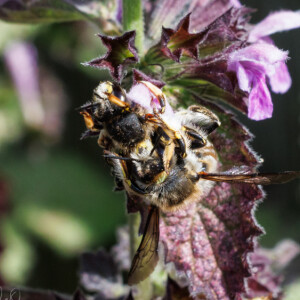Post-coital munchies
Chronologically, this is the last of today's sequence of three photos, but I'm featuring it because of its energy.
Who am I kidding? I'm featuring it because it's really quite hard to capture Wool Carder Bees in flight, and having done it (albeit with a smidge of motion blur), I'm far too immature to downplay the achievement.
Anyway. The first extra shows a female Wool Carder (remember, the mnemonic here is: if it's wearing white knees socks and looks like a hefty great American footballer, it's a male; but if it's more compact, and seems to be sporting fluffy yellow legwarmers, it's a female), which landed on the wall next to me while I was photographing some Skippers on the black horehound. This sight was unusual enough to catch my attention, because female Wool Carders are generally busy foraging for their nests, and keep themselves to themselves so as to avoid being hassled by the males. It's only with the benefit of hindsight that I've constructed a little fantasy of having seen her take a deep breath and square her tiny shoulders, but what's definitely true is that after resting on the wall for about ten seconds she flew to the nearest horehound spike and landed.
Almost instantaneously this male swooped in from left field and pounced, and my second extra shows their brutal but brief coupling. He then dismounted in the usual way for this species, which is to say he simply let go and fell backwards into the air, before righting himself and zooming off, tongue extended, in search of a post-coital snack. By the time he'd sugared up and was back on patrol, looking for his next chance to fulfil the biological imperative, the female had quietly removed herself from the firing line.
Many, if not most, female solitary bees will only mate once in their lives, and for the males, the chance to mate comes down to being lucky enough to find an unmated and receptive female, and fast enough to grab her before anyone else does. In these species the males are almost always smaller than the females, and if their advances are unwelcome the females have no problem shaking them off. Wool Carder females, though, mate throughout their lives, and the males are so much larger, stronger, and fiercer, that the only way they can avoid copulation is simply not to get caught.
I haven't been able to find much information about the nesting biology of this species, so this is pure speculation, but having watched this female appear to deliberately put herself in the way of a patrolling male (as opposed to the many times I've seen females fly away so fast from an approaching male that they seemed almost to dematerialise), I wonder if they're similar to female dragonflies, which are also promiscuous, but will only volunteer themselves for mating when they've matured a batch of eggs and need them to be fertilised. Whatever the psychology, the advantage to a female Wool Carder of having to endure regular Viking raids like this is that her offspring are likely to be fathered by a range of different males - in other words (arf, arf), she avoids carrying all her eggs in the same evolutionary basket. Having said which, it's obviously likely that the biggest, toughest, and fastest males - like this one - will get to mate most often, and father the highest proportion of the next generation.
R: C3, D14.



Comments
Sign in or get an account to comment.


